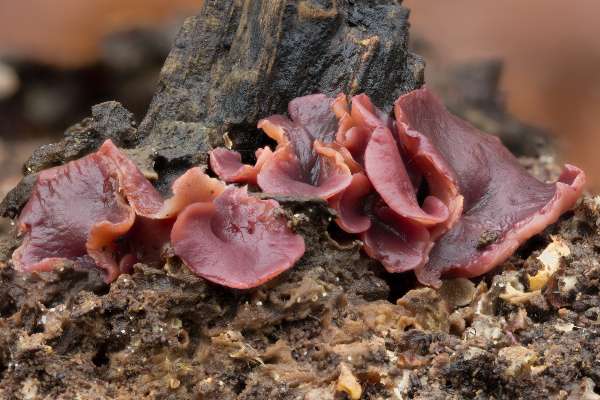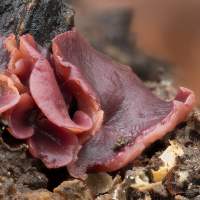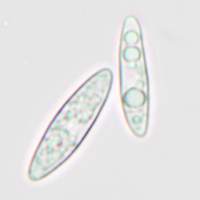Ascocoryne cylichnium (Tul.) Korf
Phylum: Ascomycota - Class: Leotiomycetes - Order: Leotiales - Family: Gelatinodiscaceae
Distribution - Taxonomic History - Etymology - Identification - Culinary Notes - Reference Sources

Found on the rotting trunks and branches of various hardwoods, this wood-rotting cup fungus can form conspicuous clusters.
Distribution
Fairly common and widespread throughout Britain and Ireland, Ascocoryne cylichnium is also found in mainland Europe wherever the are broadleaf woodlands or parklands where fallen timber is allowed to rot away naturally. This ascomycete occurs in many other parts of the world including North America.
Taxonomic history
This species was first described in 1853 by Louis René Étienne (known as Edmond) Tulasne (1815 - 1885), who gave it the scientific name Peziza cylichnium. It was Americam mycologist Richard Paul Korf 1925 - 2016) who, in 1971, transferred this species to the genus Ascocoryne, thereby establishing its currently-accepted scientific name Ascocoryne cylichnium.
Synonyms of Ascocoryne cylichnium include Peziza cylichnium Tul., Coryne cylichnium (Tul.) Sacc., Coryne sarcoides var. cylichnium (Tul.) Rehm, Bulgaria urnalis Nyl., and Ombrophila urnalis (Nyl.) P. Karst., Coryne urnalis (Nyl.) Sacc.
Etymology
Ascocoryne, the genus name, is made up of Asco- the prefix indicating that this fungus belongs to the phylum Ascomycota (fungi whose sexual spores are produced inside asci), and coryne which comes from from the Greek corönë meaning 'knotted rod'. The specific epithet cylichnium comes from the Greek for a goblet - a reference to the shape of the fruitbodies.
Identification guide
 |
FruitbodyDarkish purple; disc or cup-shaped with a short stem individual fruitbodies grow up to 2cm across, often pushing up against and so distorting one another. The smooth upper (inner, when cup shaped) surface is fertile and contains the asci. (There is no known anamorph of this species.) The flesh is gelatinous. |
AsciTypically 190-210 x 13-15µm, with eight spores in each ascus. ParaphysesNarrow, clavate, tips typically 3µm across. |
|
 |
AscosporesEllipsoidal, smooth, septate when mature, 20-24 x 5.5-6µm; hyaline; each spore usually contains two oil drops. Show larger imageSpore printWhite. |
Odour/taste |
Not distinctive. |
Habitat & Ecological role |
Saprobic, on rotting trunks and stumps of broadleaf trees. |
Season |
Fruiting in late summer, autumn and early winter. |
Similar species |
Ascocoryne sarcoides at its telemorphic stage is similar; it can be identified with certainly by microscopic study of the spores, which are smaller than those of Ascocoryne cylichnium. |
Culinary Notes
This insubstantial fungus is generally regarded as inedible.
Reference Sources
Fascinated by Fungi, 2nd Edition, Pat O'Reilly 2016, reprinted by Coch-y-bonddu Books in 2022.
Groves J W, Wilson D E (1967). The nomenclatural status of Coryne. Taxon 16 (1): 35–41
Dennis, R.W.G. (1981). British Ascomycetes; Lubrecht & Cramer; ISBN: 3768205525.
Dictionary of the Fungi; Paul M. Kirk, Paul F. Cannon, David W. Minter and J. A. Stalpers; CABI, 2008
Taxonomic history and synonym information on these pages is drawn from many sources but in particular from the British Mycological Society's GB Checklist of Fungi.
Acknowledgements
This page includes pictures kindly contributed by Simon Harding, David Kelly and Richard Shotbolt.
Fascinated by Fungi. Back by popular demand, Pat O'Reilly's best-selling 450-page hardback book is available now. The latest second edition was republished with a sparkling new cover design in September 2022 by Coch-y-Bonddu Books. Full details and copies are available from the publisher's online bookshop...


